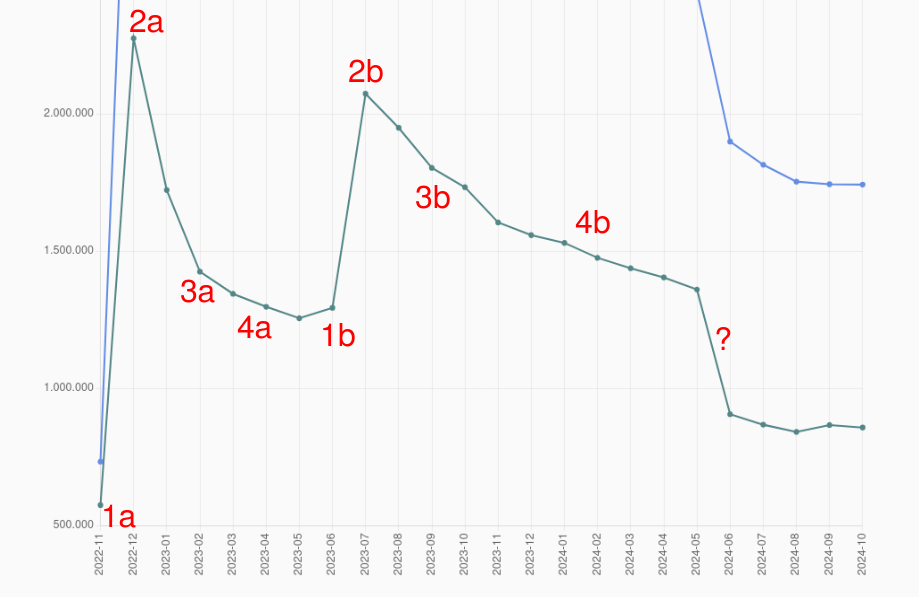I don’t like the clickbait title at all – Mastodon’s clearly going to survive, at least for the forseeable future, and it wouldn’t surprise me if it outlives Xitter.
Still, Mastodon is struggling; most of the people who checkd it out in the November 2022 surge (or the smaller June 2023 surge) didn’t stick around, and numbers have been steadily declining for the last year. The author makes some good points, and some of the comments are excellent.
The slopes you meassure are still tied to the preceeding surges, so I can’t treat them as any indication of success/failure.
To me it kinda looks like we are in the trough of disillusionment, which is a normal period of any new tech/system.
With improvements to the network we soon hit the slope of enlightenment.
Context for other users - the user above is likely referring to the Gartner cycle:

As anyone here can see, it looks nothing like that pattern that I’ve highlighted.
If the success condition for Mastodon is “to become a long-term viable and attractive alternative to corporate-owned microblogging”, then improvements of the platform are necessary.
To be clear on my opinion in this matter: I want to see Mastodon to succeed, I want to see X and Threads closing down, and IDGAF about Bluesky. However I’m not too eager to engage in wishful belief and pretend that everything is fine - because acknowledging the problem is always the first step to solve it.
You are absolutely right that I am refering to the Gartner cycle.
It doesn’t fit exactly, but the general pattern fit very well with the first half.
The Mastodon graph just happens to have two hype sections.
A model that explains well half of the data is as useful as a coin toss. But let’s roll with it, and pretend that we got two superimposed Gartner cycles here.
The trough would be reached after a sharp drop after the peak, and based on the first peak it would be ~2 months long. That would explain only the period between 2023-07 and 2023-09; the rest of what I’ve pointed out in red is clearly something else, the nearest of what they look like would be a sick version of the “slope of enlightenment” - going down instead of up.

Yeah, the model doesn’t work.
A better way to approach this is to consider three things:
- The main selling point is federation.
- Federation is only perceived as useful for your typical user when a competitor abuses power.
- Mastodon has the drawbacks already mentioned all the time, not just when the competitors fuck it up.
Once you notice those things, it gets really easy to explain what’s happening:
- the peaks are caused by Musk’s acquisition of Reddit and Threads being released (as it brought a lot of discussion about federation up)
- overexcitable people take 1~2 months to realise that Mastodon is not just “Twitter minus Musk”.
- the drawbacks are always there, so Mastodon slowly bleeds users, while only gathering new ones when Musk/Zuckenberg/etc. do something shitty.
By analysing the data this way, not just we’re describing it better, but we can also see where Mastodon needs to improve:
- It needs killer features that are clearly visible for everyone, regardless of federation or “Musk pissed off users”
- It needs to be promoted better. Even among non-Twitter/Bluesky/Threads users.
- Federation itself needs to be promoted better, with simple words, showing why leaving Twitter for yet another walled garden won’t solve shite in the long run.
What I’m saying also partially applies to the “Fediverse link aggregators”, like Lemmy. Lemmy does show some tendency to bleed users, but in smaller degree than Mastodon; but it’s in a better position because there’s only one big competitor, and it keeps fucking it up over and over.


